inflation pressure JEEP WRANGLER 2008 Owners Manual
[x] Cancel search | Manufacturer: JEEP, Model Year: 2008, Model line: WRANGLER, Model: JEEP WRANGLER 2008Pages: 466, PDF Size: 8.61 MB
Page 211 of 466
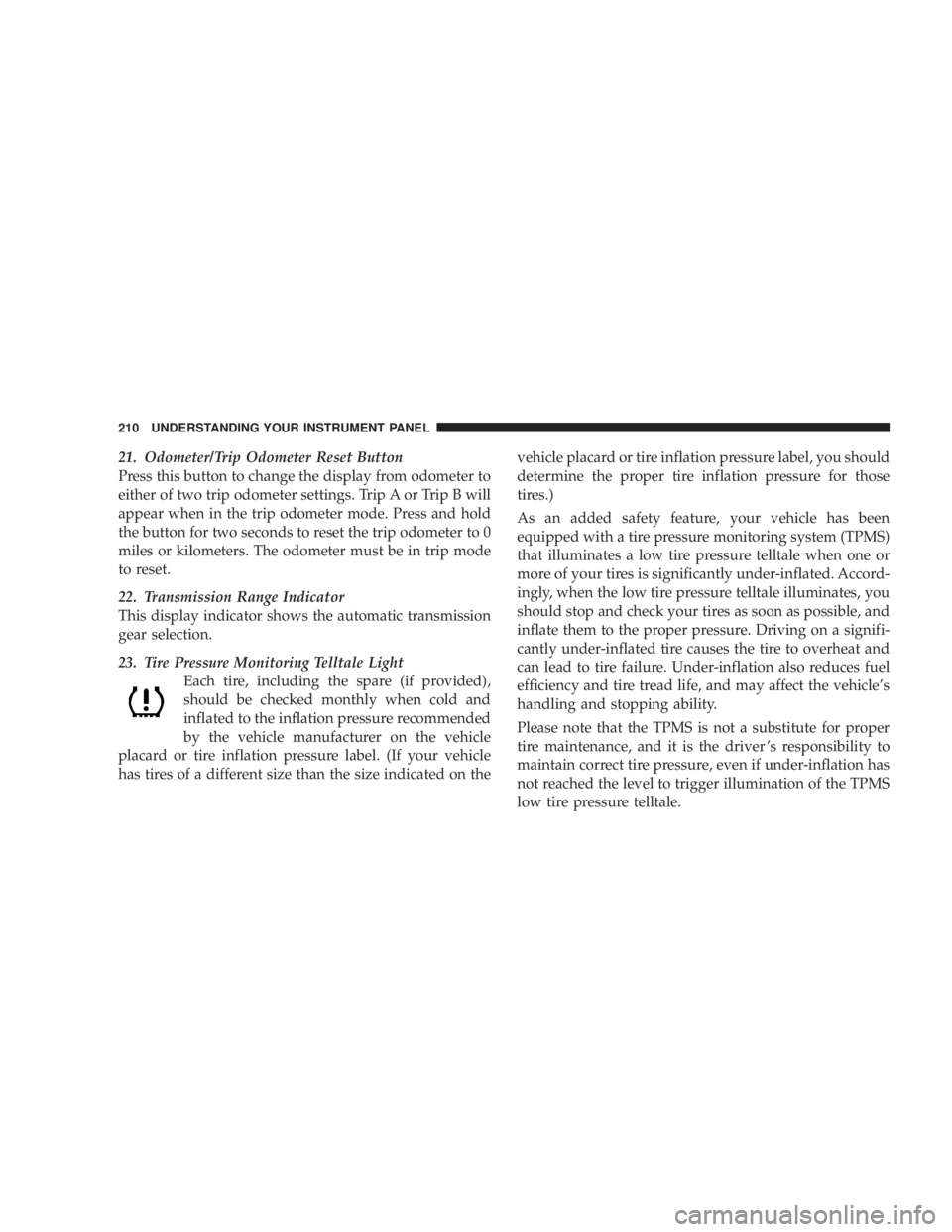
21. Odometer/Trip Odometer Reset Button
Press this button to change the display from odometer to
either of two trip odometer settings. Trip A or Trip B will
appear when in the trip odometer mode. Press and hold
the button for two seconds to reset the trip odometer to 0
miles or kilometers. The odometer must be in trip mode
to reset.
22. Transmission Range Indicator
This display indicator shows the automatic transmission
gear selection.
23. Tire Pressure Monitoring Telltale LightEach tire, including the spare (if provided),
should be checked monthly when cold and
inflated to the inflation pressure recommended
by the vehicle manufacturer on the vehicle
placard or tire inflation pressure label. (If your vehicle
has tires of a different size than the size indicated on the vehicle placard or tire inflation pressure label, you should
determine the proper tire inflation pressure for those
tires.)
As an added safety feature, your vehicle has been
equipped with a tire pressure monitoring system (TPMS)
that illuminates a low tire pressure telltale when one or
more of your tires is significantly under-inflated. Accord-
ingly, when the low tire pressure telltale illuminates, you
should stop and check your tires as soon as possible, and
inflate them to the proper pressure. Driving on a signifi-
cantly under-inflated tire causes the tire to overheat and
can lead to tire failure. Under-inflation also reduces fuel
efficiency and tire tread life, and may affect the vehicle’s
handling and stopping ability.
Please note that the TPMS is not a substitute for proper
tire maintenance, and it is the driver ’s responsibility to
maintain correct tire pressure, even if under-inflation has
not reached the level to trigger illumination of the TPMS
low tire pressure telltale.
Page 311 of 466
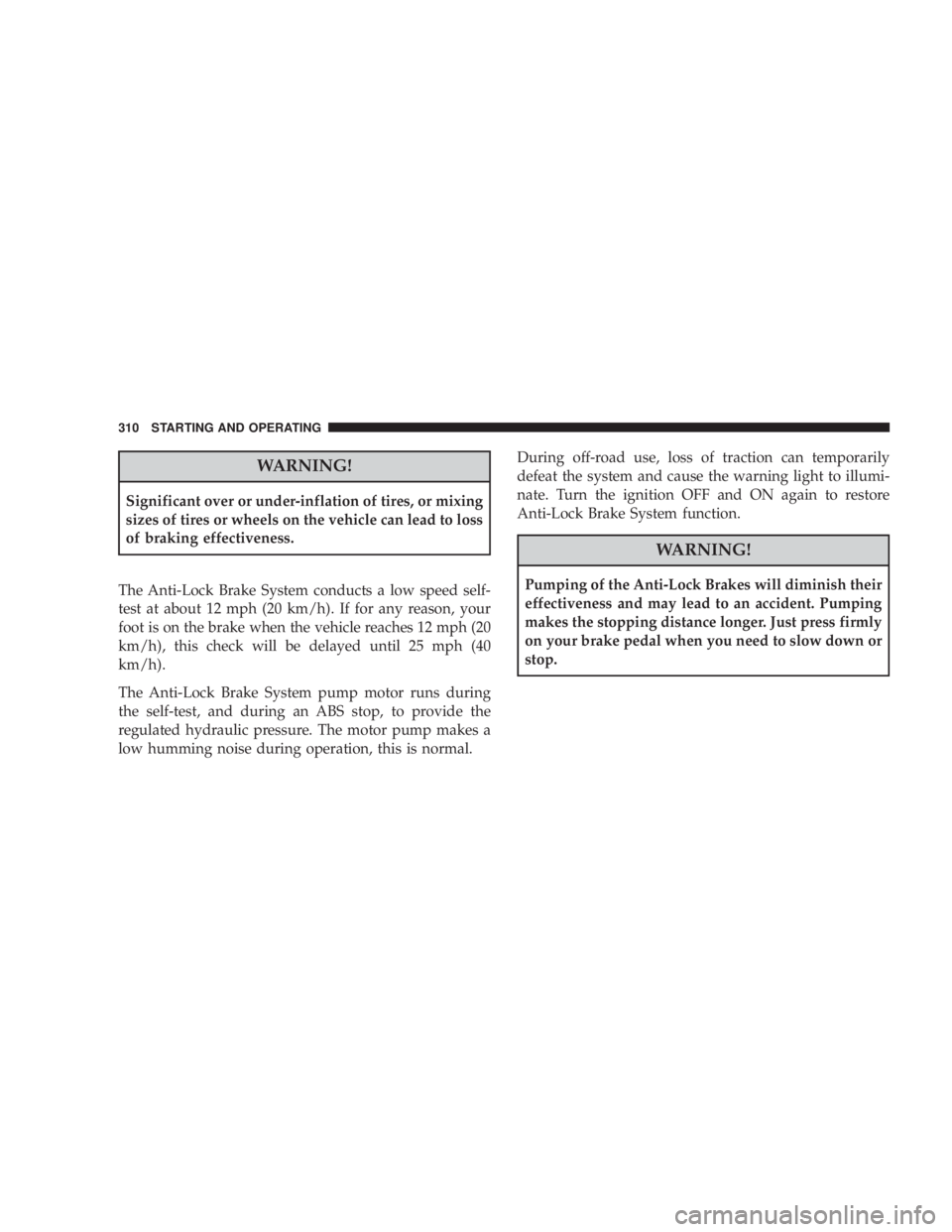
WARNING!
Significant over or under-inflation of tires, or mixing
sizes of tires or wheels on the vehicle can lead to loss
of braking effectiveness.
The Anti-Lock Brake System conducts a low speed self-
test at about 12 mph (20 km/h). If for any reason, your
foot is on the brake when the vehicle reaches 12 mph (20
km/h), this check will be delayed until 25 mph (40
km/h).
The Anti-Lock Brake System pump motor runs during
the self-test, and during an ABS stop, to provide the
regulated hydraulic pressure. The motor pump makes a
low humming noise during operation, this is normal. During off-road use, loss of traction can temporarily
defeat the system and cause the warning light to illumi-
nate. Turn the ignition OFF and ON again to restore
Anti-Lock Brake System function.
Page 319 of 466
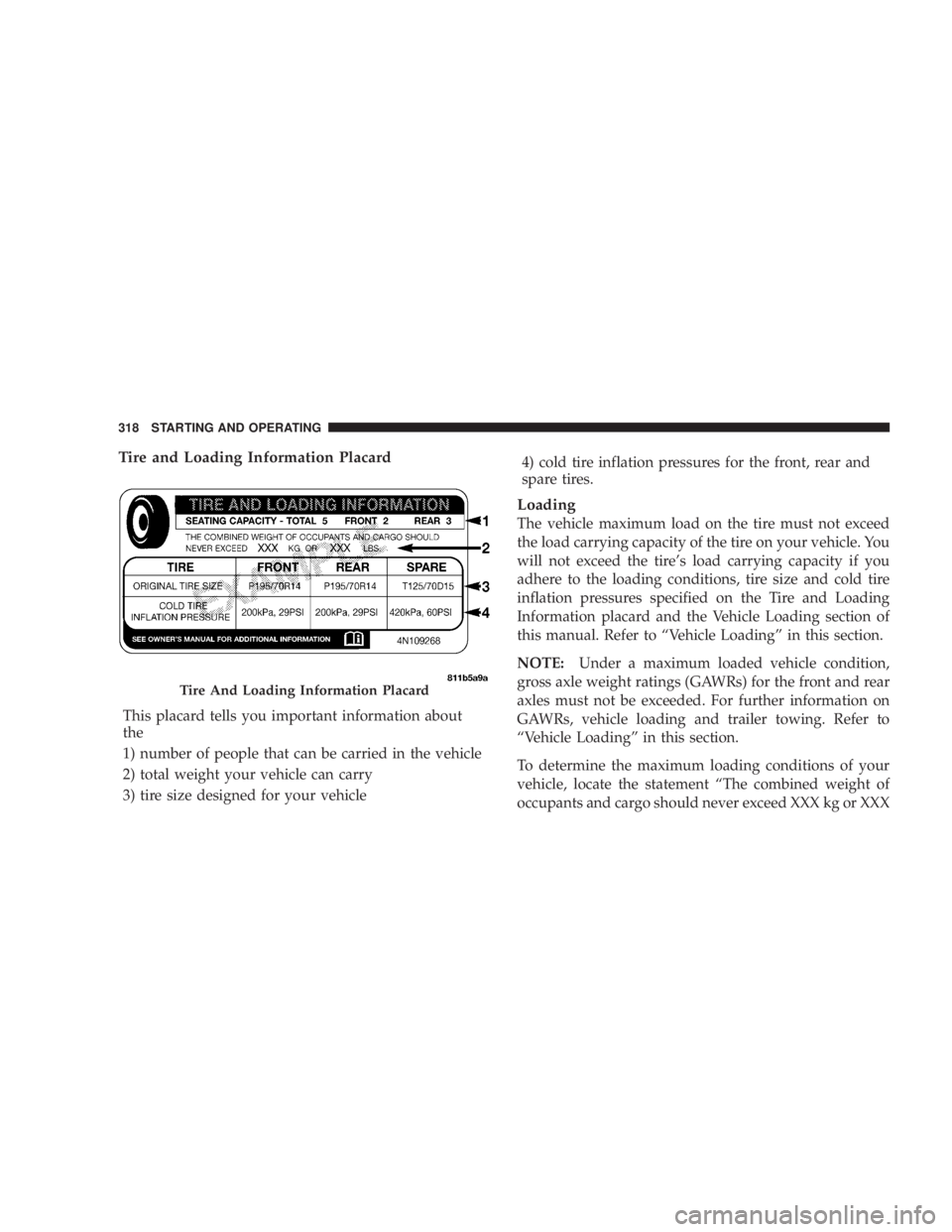
Tire and Loading Information Placard
This placard tells you important information about
the
1) number of people that can be carried in the vehicle
2) total weight your vehicle can carry
3) tire size designed for your vehicle4) cold tire inflation pressures for the front, rear and
spare tires.
Loading
The vehicle maximum load on the tire must not exceed
the load carrying capacity of the tire on your vehicle. You
will not exceed the tire’s load carrying capacity if you
adhere to the loading conditions, tire size and cold tire
inflation pressures specified on the Tire and Loading
Information placard and the Vehicle Loading section of
this manual. Refer to “Vehicle Loading” in this section.
NOTE:
Under a maximum loaded vehicle condition,
gross axle weight ratings (GAWRs) for the front and rear
axles must not be exceeded. For further information on
GAWRs, vehicle loading and trailer towing. Refer to
“Vehicle Loading” in this section.
To determine the maximum loading conditions of your
vehicle, locate the statement “The combined weight of
occupants and cargo should never exceed XXX kg or XXX
Page 323 of 466
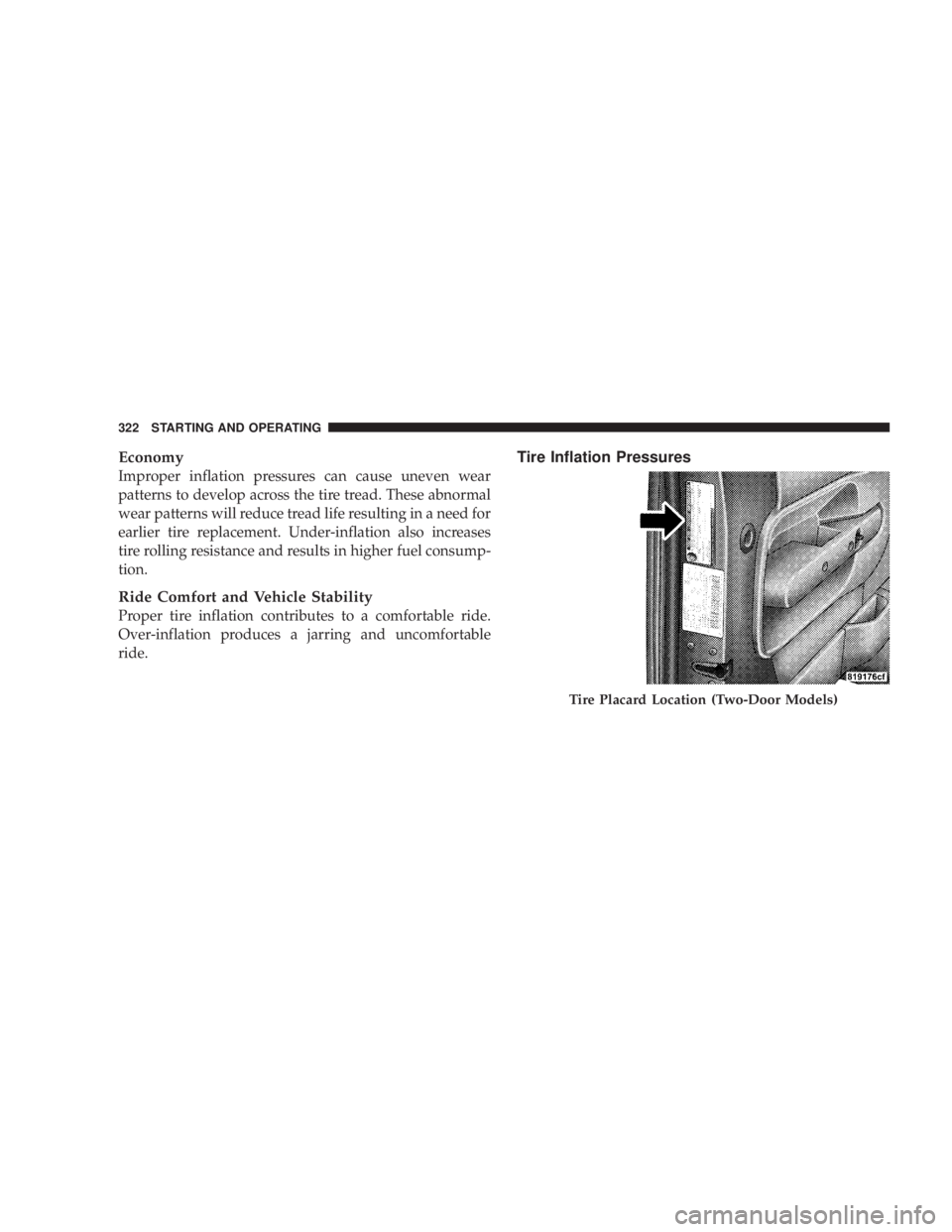
Economy
Improper inflation pressures can cause uneven wear
patterns to develop across the tire tread. These abnormal
wear patterns will reduce tread life resulting in a need for
earlier tire replacement. Under-inflation also increases
tire rolling resistance and results in higher fuel consump-
tion.
Ride Comfort and Vehicle Stability
Proper tire inflation contributes to a comfortable ride.
Over-inflation produces a jarring and uncomfortable
ride.
Tire Inflation Pressures
Page 325 of 466
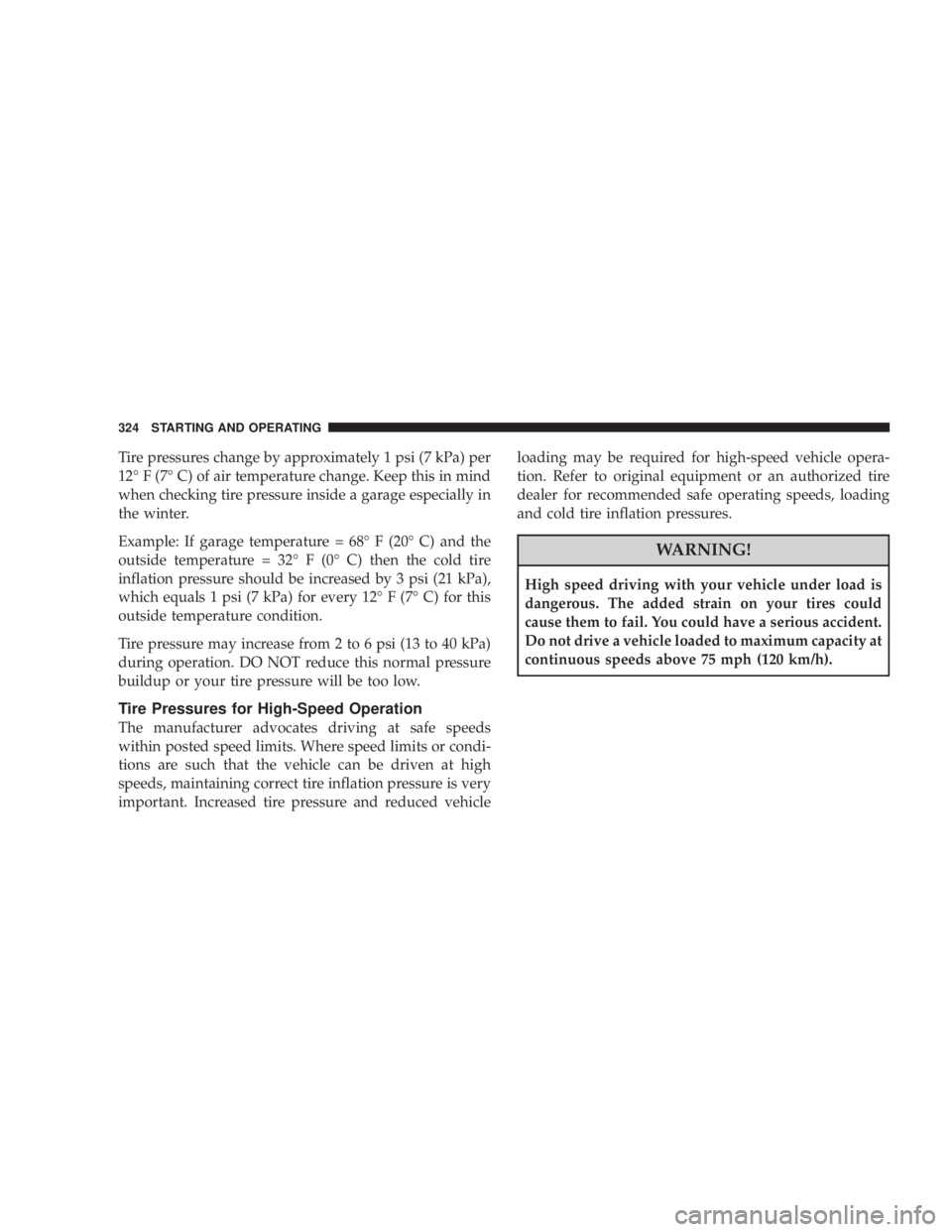
Tire pressures change by approximately 1 psi (7 kPa) per
12° F (7° C) of air temperature change. Keep this in mind
when checking tire pressure inside a garage especially in
the winter.
Example: If garage temperature = 68° F (20° C) and the
outside temperature = 32° F (0° C) then the cold tire
inflation pressure should be increased by 3 psi (21 kPa),
which equals 1 psi (7 kPa) for every 12° F (7° C) for this
outside temperature condition.
Tire pressure may increase from 2 to 6 psi (13 to 40 kPa)
during operation. DO NOT reduce this normal pressure
buildup or your tire pressure will be too low.
Tire Pressures for High-Speed Operation
The manufacturer advocates driving at safe speeds
within posted speed limits. Where speed limits or condi-
tions are such that the vehicle can be driven at high
speeds, maintaining correct tire inflation pressure is very
important. Increased tire pressure and reduced vehicleloading may be required for high-speed vehicle opera-
tion. Refer to original equipment or an authorized tire
dealer for recommended safe operating speeds, loading
and cold tire inflation pressures.
Page 331 of 466
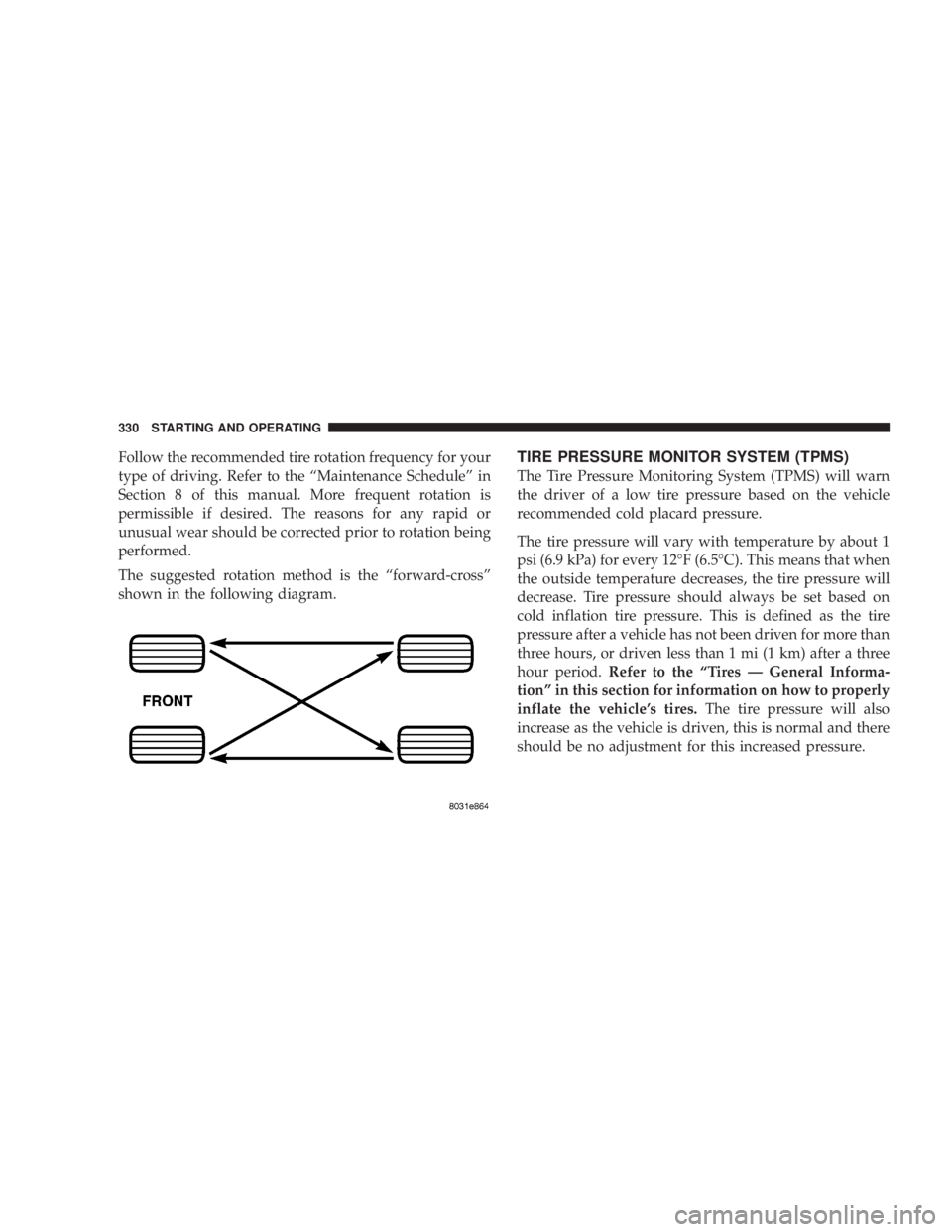
Follow the recommended tire rotation frequency for your
type of driving. Refer to the “Maintenance Schedule” in
Section 8 of this manual. More frequent rotation is
permissible if desired. The reasons for any rapid or
unusual wear should be corrected prior to rotation being
performed.
The suggested rotation method is the “forward-cross”
shown in the following diagram.TIRE PRESSURE MONITOR SYSTEM (TPMS)
The Tire Pressure Monitoring System (TPMS) will warn
the driver of a low tire pressure based on the vehicle
recommended cold placard pressure.
The tire pressure will vary with temperature by about 1
psi (6.9 kPa) for every 12°F (6.5°C). This means that when
the outside temperature decreases, the tire pressure will
decrease. Tire pressure should always be set based on
cold inflation tire pressure. This is defined as the tire
pressure after a vehicle has not been driven for more than
three hours, or driven less than 1 mi (1 km) after a three
hour period.Refer to the “Tires — General Informa-
tion” in this section for information on how to properly
inflate the vehicle’s tires. The tire pressure will also
increase as the vehicle is driven, this is normal and there
should be no adjustment for this increased pressure.
Page 335 of 466
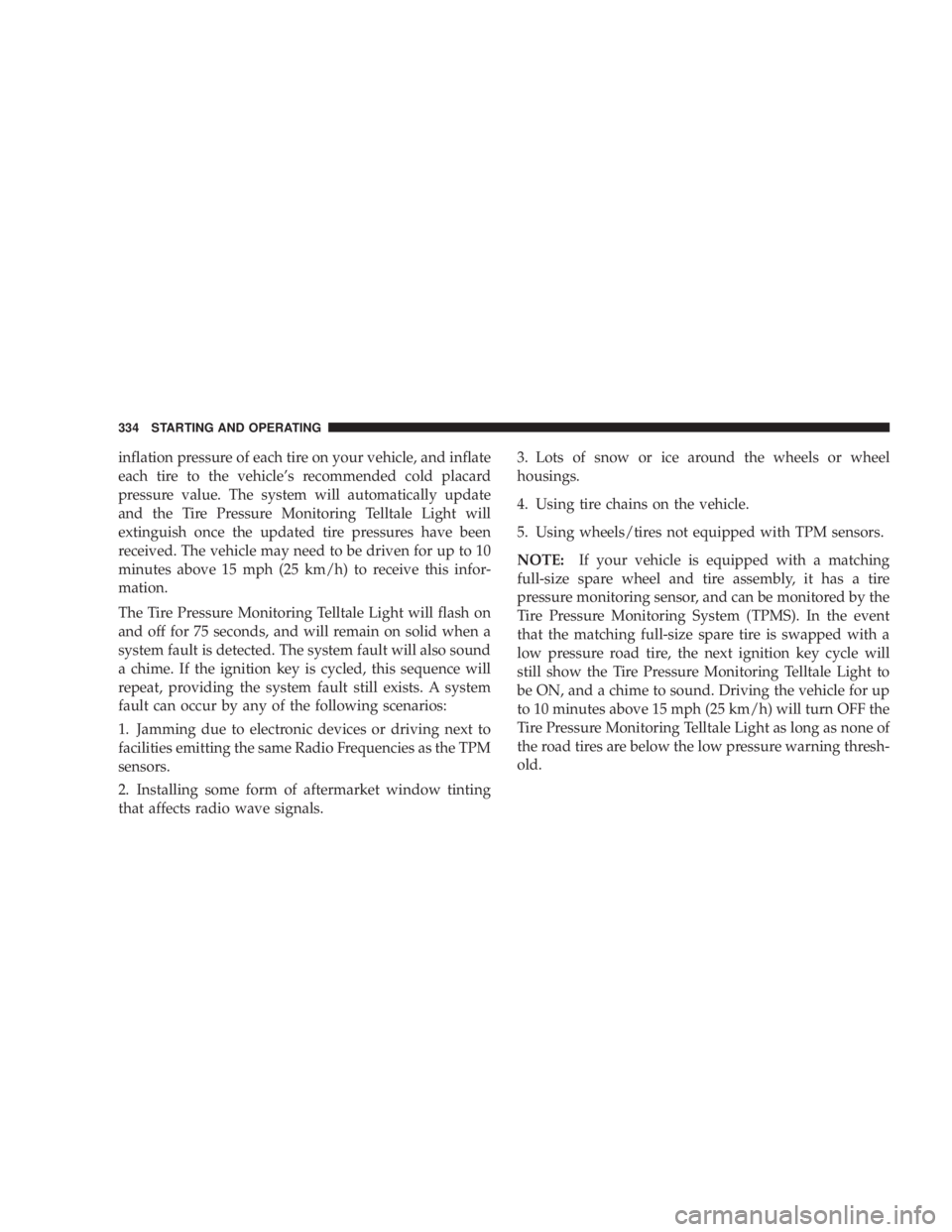
inflation pressure of each tire on your vehicle, and inflate
each tire to the vehicle’s recommended cold placard
pressure value. The system will automatically update
and the Tire Pressure Monitoring Telltale Light will
extinguish once the updated tire pressures have been
received. The vehicle may need to be driven for up to 10
minutes above 15 mph (25 km/h) to receive this infor-
mation.
The Tire Pressure Monitoring Telltale Light will flash on
and off for 75 seconds, and will remain on solid when a
system fault is detected. The system fault will also sound
a chime. If the ignition key is cycled, this sequence will
repeat, providing the system fault still exists. A system
fault can occur by any of the following scenarios:
1. Jamming due to electronic devices or driving next to
facilities emitting the same Radio Frequencies as the TPM
sensors.
2. Installing some form of aftermarket window tinting
that affects radio wave signals.3. Lots of snow or ice around the wheels or wheel
housings.
4. Using tire chains on the vehicle.
5. Using wheels/tires not equipped with TPM sensors.
NOTE:
If your vehicle is equipped with a matching
full-size spare wheel and tire assembly, it has a tire
pressure monitoring sensor, and can be monitored by the
Tire Pressure Monitoring System (TPMS). In the event
that the matching full-size spare tire is swapped with a
low pressure road tire, the next ignition key cycle will
still show the Tire Pressure Monitoring Telltale Light to
be ON, and a chime to sound. Driving the vehicle for up
to 10 minutes above 15 mph (25 km/h) will turn OFF the
Tire Pressure Monitoring Telltale Light as long as none of
the road tires are below the low pressure warning thresh-
old.
334 STARTING AND OPERATING
Page 461 of 466
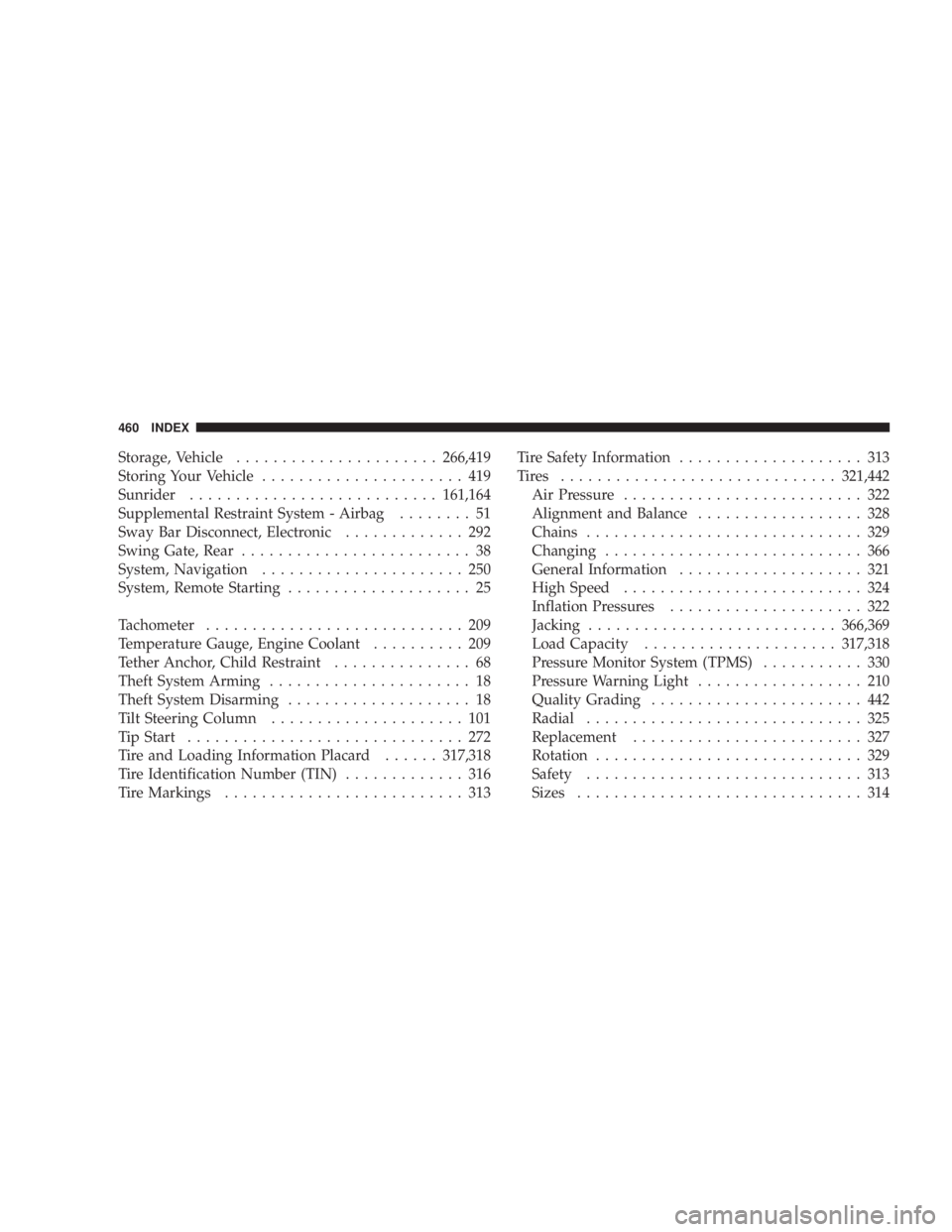
Storage, Vehicle...................... 266,419
Storing Your Vehicle ...................... 419
Sunrider ........................... 161,164
Supplemental Restraint System - Airbag ........ 51
Sway Bar Disconnect, Electronic ............. 292
Swing Gate, Rear ......................... 38
System, Navigation ...................... 250
System, Remote Starting .................... 25
Tachometer ............................ 209
Temperature Gauge, Engine Coolant .......... 209
Tether Anchor, Child Restraint ............... 68
Theft System Arming ...................... 18
Theft System Disarming .................... 18
Tilt Steering Column ..................... 101
Tip Start .............................. 272
Tire and Loading Information Placard ......317,318
Tire Identification Number (TIN) ............. 316
Tire Markings .......................... 313 Tire Safety Information
.................... 313
Tires .............................. 321,442
Air Pressure .......................... 322
Alignment and Balance .................. 328
Chains .............................. 329
Changing ............................ 366
General Information .................... 321
High Speed .......................... 324
Inflation Pressures ..................... 322
Jacking ........................... 366,369
Load Capacity ..................... 317,318
Pressure Monitor System (TPMS) ........... 330
Pressure Warning Light .................. 210
Quality Grading ....................... 442
Radial .............................. 325
Replacement ......................... 327
Rotation ............................. 329
Safety .............................. 313
Sizes ............................... 314
460 INDEX
Page 465 of 466

INTRODUCTION INTRODUCTION ROLLOVER WARNING HOW TO USE THIS MANUAL WARNINGS AND CAUTIONS VEHICLE IDENTIFICATION NUMBER VEHICLE MODIFICATIONS/ALTERATIONS THINGS TO KNOW BEFORE STARTING YOUR VEHICLE A WORD
ABOUT YOUR KEYS Ignition Key RemovalKey-In-Ignition ReminderSTEERING WHEEL LOCK To Manually Lock the Steering WheelTo Release the Steering Wheel LockSENTRY KEY Replacement KeysCustomer Key ProgrammingGeneral InformationSECURITY ALARM
SYSTEM - IF EQUIPPED To Set the AlarmTo Disarm the SystemILLUMINATED ENTRY REMOTE KEYLESS ENTRY - IF EQUIPPED To Unlock the Doors and Swing GateTo Lock the Doors and Swing GateUsing The Panic AlarmTo Turn Off Flash Lights With Lock
Programming Additional TransmittersGeneral InformationBattery ReplacementREMOTE STARTING SYSTEM - IF EQUIPPED DOORS Upper Half Door Window Removal (If Equipped)Upper Half Door Window Installation (If Equipped)Front Door RemovalRear Door Removal
(Four-Door Models)DOOR LOCKS Manual Door LocksPower Door Locks - If EquippedAutomatic Unlock Doors On ExitAutomatic Door LocksWINDOWS Power Windows - If EquippedRear Power Windows (Four-Door Models Only)Wind BuffetingREAR SWING GATE
OCCUPANT RESTRAINTS Lap/Shoulder BeltsRear Center Lap/Shoulder Belt Retractor Lock-Out (Four-Door Models Only)Adjustable Upper Shoulder Belt AnchorageSeat Belt PretensionersEnhanced Seat Belt Use Reminder System (BeltAlert)Seat Belts And Pregnant
WomenSeat Belt ExtenderDriver And Front Passenger Supplemental Restraint Systems (SRS) Child RestraintENGINE BREAK-IN RECOMMENDATIONS SAFETY TIPS Exhaust GasSafety Checks You Should Make Inside The VehicleSafety Checks You Should Make
Outside The VehicleUNDERSTANDING THE FEATURES OF YOUR VEHICLE MIRRORS Inside Day/Night MirrorOutside MirrorsHANDS-FREE COMMUNICATION (UConnect) SEATS Front Seat AdjustmentManual Seat Height Adjustment - If EquippedFront Seatback
ReclineFront Easy Entry Seats (Two-Door Models)Head RestraintsFold And Tumble Rear Seat (Two-Door Models)Removing the Rear Seat (Two-Door Models)Replacing the Rear Seat (Two-Door Models)60/40 Split Folding Rear Seat (Four-Door Models)To Raise the Rear
SeatTO OPEN AND CLOSE THE HOOD LIGHTS Interior LightsMultifunction Control LeverParking Lights, Instrument Panel Lights, and HeadlightsLights-On ReminderHeadlight Dimmer SwitchPassing LightFront Fog Lights - If EquippedTurn SignalsDaytime Running Lights
- If EquippedWINDSHIELD WIPERS AND WASHERS Intermittent Wiper SystemWindshield Wiper OperationWindshield WashersMist FeatureTILT STEERING COLUMN ELECTRONIC SPEED CONTROL - IF EQUIPPED To ActivateTo Set At A Desired SpeedTo Deactivate
To Resume SpeedTo Vary The Speed SettingManual TransmissionTo Accelerate For PassingELECTRONIC BRAKE CONTROL SYSTEM ABS (Anti-Lock Brake System)TCS (Traction Control System)BAS (Brake Assist System)ERM (Electronic Roll Mitigation)ESP (Electronic
Stability Program)ESP/BAS Warning LightELECTRICAL POWER OUTLET Electrical Outlet Use With Engine OffCUPHOLDERS Front CupholdersRear CupholdersSTORAGE Console Storage CompartmentRear Storage CompartmentDUAL TOP - IF EQUIPPED Removing
The Soft TopInstalling the Soft TopFREEDOM TOP THREE-PIECE MODULAR HARD TOP Front Panel(s) RemovalFront Panel(s) InstallationFront Panel(s) Installation Only (With Rear Hard Top Removed)Rear Hard Top RemovalRear Hard Top InstallationDOOR FRAME
Door Frame Removal (Two-Door Models)Door Frame Installation (Two-Door Models)Door Frame Removal (Four-Door Models)Door Frame Installation (Four-Door Models)SOFT TOP (TWO-DOOR MODELS) Folding Down The Soft Top Putting Up The Soft Top SUNRIDER
(TWO-DOOR MODELS) - IF EQUIPPED SUNRIDER (FOUR-DOOR MODELS) - IF EQUIPPED SOFT TOP (FOUR-DOOR MODELS) Folding Down The Soft Top Putting Up The Soft Top FOLDING WINDSHIELD Lowering The Windshield And Removing Side BarsRaising
The Windshield And Replacing Side BarsREAR WINDOW FEATURES - HARD TOP ONLY Rear Window Wiper/Washer - If EquippedRear Window Defroster - If EquippedUNDERSTANDING YOUR INSTRUMENT PANEL INSTRUMENT PANEL AND CONTROLS
INSTRUMENT CLUSTER INSTRUMENT CLUSTER DESCRIPTION COMPASS AND TRIP COMPUTER - IF EQUIPPED Control ButtonsTrip ConditionsCompass Temperature DisplayRADIO GENERAL INFORMATION Radio Broadcast SignalsTwo Types of SignalsElectrical
DisturbancesAM ReceptionFM ReceptionSALES CODE RES - AM/FM STEREO RADIO WITH CD PLAYER (MP3 AUX JACK) Operating Instructions - Radio ModeOperation Instructions - CD MODE for CD and MP3 Audio PlayNotes On Playing MP3 FilesLIST Button (CD
Mode for MP3 Play)INFO Button (CD Mode for MP3 Play)SALES CODE REQ - AM/FM STEREO RADIO AND 6-DISC CD/DVD CHANGER (MP3/WMA AUX JACK) Operating Instructions - Radio ModeOperation Instructions - (DISC MODE for CD and MP3/WMA Audio
Play, DVD-VIDEO)Notes On Playing MP3/WMA FilesLIST Button (DISC Mode for MP3/WMA Play)INFO Button (DISC Mode for MP3/WMA Play)SALES CODE RER - MULTIMEDIA SYSTEM - IF EQUIPPED Operating Instructions - Satellite RadioOperating Instructions -
Hands-Free Communication (UConnect) (If Equipped)Clock Setting ProcedureSATELLITE RADIO - IF EQUIPPED (REN/REQ/RER/RES RADIOS ONLY) System Act ivationElectronic Serial Number/Sirius Identification Number (ESN/SID)Selecting Satellite ModeSatellite
AntennaReception QualityOperating Instructions - Satellite ModeOperating Instructions - Hands-Free Phone (If Equipped)Operating Instruction s - Video Entertainment System (VES) (If Equipped)CD/DVD DISC MAINTENANCE RADIO OPERATION AND CELLULAR
PHONES CLIMATE CONTROLS Manual Heater OnlyManual Air Conditioning and Heating System - If EquippedAir ConditioningOperating TipsSTARTING AND OPERATING STARTING PROCEDURES Manual TransmissionAutomatic TransmissionNormal StartingExtreme
Cold Weather (below -20 degrees F or -29 degrees C)If Engine Fails to StartAfter StartingENGINE BLOCK HEATER - IF EQUIPPED MANUAL TRANSMISSION ShiftingDownshiftingReverse ShiftingAUTOMATIC TRANSMISSION Shift Lock Manual Override
Brake/Transmission Interlock SystemAutomatic Transmission with OverdriveFOUR-WHEEL DRIVE OPERATION (COMMAND-TRAC OR ROCK-TRAC) - IF EQUIPPED Operating Instructions/PrecautionsShift PositionsShifting ProcedureTRAC-LOK REAR AXLE - IF
EQUIPPED AXLE LOCK (TRU-LOK) - RUBICON MODELS REAR AXLE LOCK - 4WD NON-RUBICON MODELS (IF EQUIPPED) ELECTRONIC SWAY BAR DISCONNECT - IF EQUIPPED ON-ROAD DRIVING TIPS OFF-ROAD DRIVING TIPS Side Step Removal - If
EquippedThe Basics of Off-Road DrivingWhen To Use 4L (Low) RangeSimultaneous Brake And Throttle OperationDriving In Snow, Mud and SandCrossing Obstacles (Rocks And Other High Points)Hill ClimbingDriving Through WaterAfter Driving Off-RoadPARKING BRAKE
ANTI-LOCK BRAKE SYSTEM POWER STEERING TIRE SAFETY INFORMATION Tire Markings Tire Identification Number (TIN)Tire Loading and Tire PressureTIRES - GENERAL INFORMATION Tire PressureTire Inflation Pressures Tire Pressures for High-Speed Operation
Radial-Ply TiresTire SpinningTread Wear IndicatorsLife of TireReplacement TiresAlignment and BalanceTIRE CHAINS TIRE ROTATION RECOMMENDATIONS TIRE PRESSURE MONITOR SYSTEM (TPMS) Base SystemGeneral InformationFUEL REQUIREMENTS
Reformulated GasolineGasoline/Oxygenate BlendsMMT In GasolineMaterials Added To FuelFuel System CautionsCarbon Monoxide WarningsADDING FUEL Fuel Filler Cap (Gas Cap)VEHICLE LOADING Certification LabelTRAILER TOWING Common Towing Definitions
Trailer Hitch ClassificationTrailer Towing Weights (Maximum Trailer Weight Ratings)Trailer and Trailer Tongue WeightTowing RequirementsTowing TipsRECREATIONAL TOWING (BEHIND MOTORHOME, ETC.) Towing - 2WD ModelsTowing - 4WD ModelsWHAT TO DO
IN EMERGENCIES HAZARD WARNING FLASHERS IF YOUR ENGINE OVERHEATS JACKING AND TIRE CHANGING Jack LocationSpare Tire StowagePreparations For JackingJacking Instructions JUMP STARTING EMERGENCY TOW HOOKS - IF EQUIPPED TOWING
A DISABLED VEHICLE MAINTAINING YOUR VEHICLE ENGINE COMPARTMENT - 3.8L ONBOARD DIAGNOSTIC SYSTEM - OBD II Loose Fuel Filler Cap MessageEMISSIONS INSPECTION AND MAINTENANCE PROGRAMS REPLACEMENT PARTS AUTHORIZED
DEALER SERVICE MAINTENANCE PROCEDURES Engine OilDrive Belts - Check Condition and TensionSpark PlugsCatalytic ConverterCrankcase Emission Control SystemFuel FilterEngine Air Cleaner FilterMaintenance-Free BatteryAir Conditioner MaintenancePower
Steering Fluid CheckDriveline And Steering Component LubricationBody LubricationWindshield Wiper BladesWindshield And Rear Window WashersExhaust SystemCooling SystemHoses and Vacuum/Vapor HarnessesBrake SystemAutomatic TransmissionHydraulic Clutch
Fluid - Manual TransmissionManual TransmissionTransfer CaseFront/Rear Axle FluidMaintenance After Off-Road DrivingAppearance Care And Protection From CorrosionFUSES (TOTALLY INTEGRATED POWER MODULE) VEHICLE STORAGE REPLACEMENT BULBS
- IF EQUIPPED BULB REPLACEMENT Head LightFront Park/Turn SignalFront Side MarkerFront Fog LightRear Tail, Stop, Turn Signal, and Backup LightsCenter High-Mounted Stop Light (CHMSL)FLUID CAPACITIES FLUIDS, LUBRICANTS AND GENUINE PARTS Engine
ChassisMAINTENANCE SCHEDULES EMISSIONS CONTROL SYSTEM MAINTENANCE MAINTENANCE SCHEDULE Required Maintenance IntervalsIF YOU NEED CONSUMER ASSISTANCE SUGGESTIONS FOR OBTAINING SERVICE FOR YOUR VEHICLE Prepare
For The AppointmentPrepare A ListBe Reasonable With RequestsIF YOU NEED ASSISTANCE DaimlerChrysler Motors Corporation Customer CenterDaimlerChrysler Canada Inc. Customer CenterIn Mexico contactCustomer Assistance For The Hearing Or Speech Impaired
(TDD/TTY)Service ContractWARRANTY INFORMATION (U.S. Vehicles Only) MOPAR PARTS REPORTING SAFETY DEFECTS In The 50 United States And Washington, D.CIn CanadaPUBLICATION ORDER FORMS DEPARTMENT OF TRANSPORTATION UNIFORM
TIRE QUALITY GRADES TreadwearTraction GradesTemperature GradesINDEX